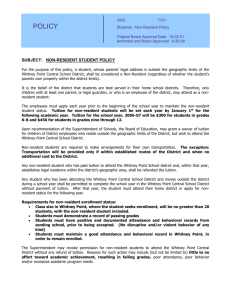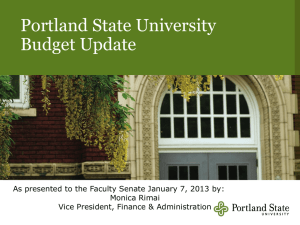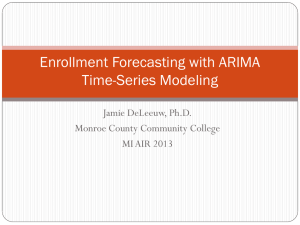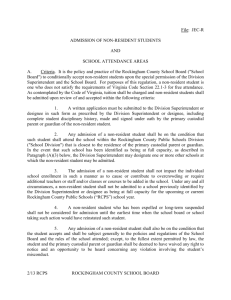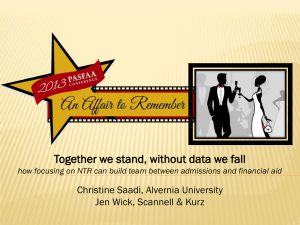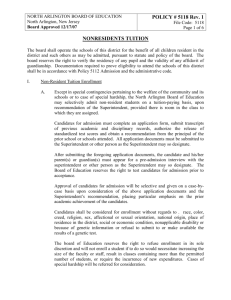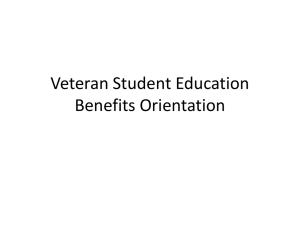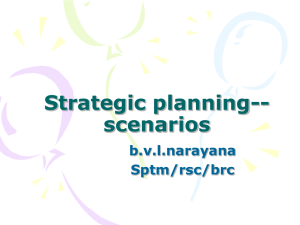Project Update - Budget Office
advertisement
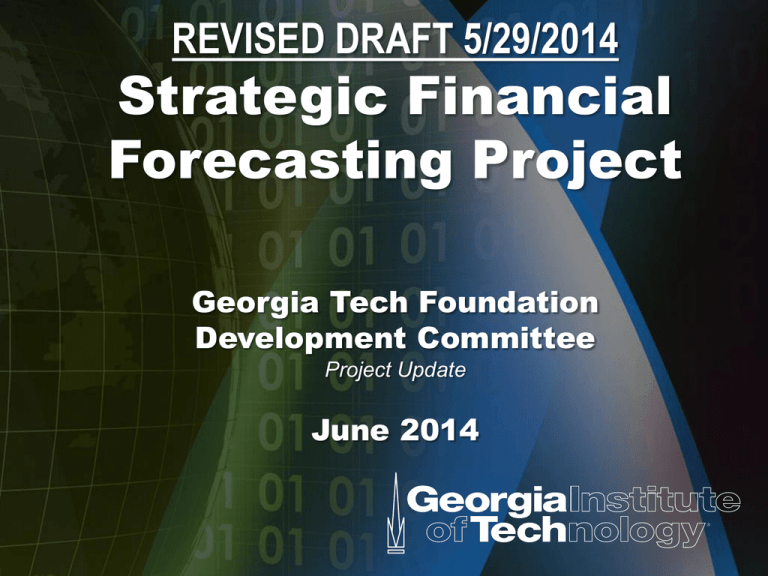
REVISED DRAFT 5/29/2014 Strategic Financial Forecasting Project Georgia Tech Foundation Development Committee Project Update June 2014 History and Background • Initiative of GTF Development Committee • Team assembled in July 2012; key core working group: David Perdue, Chair, GTF Development Committee Sandi Bramblett, DSG/Administration & Finance Emily Howell, College of Engineering Mark Long, Georgia Tech Foundation Renee Queen, GT Alumni Association Dorcas Wilkinson, Development • Continuation of Project by Decision Support Group • Sponsor: Steve Swant, Executive Vice President for Administration & Finance • Forecasting Model Implementation Directors: • Jim Kirk, Institute Budget Planning and Administration • Sandi Bramblett, Institutional Research and Planning Importance of Model in GT’s Financial Planning Process • Focus on GT Strategic Plan in building the next year’s budget • Annual budget and program proposals from colleges & other units – linked to Strategic Plan • Base budget analysis – considers performance/ workload metrics for all campus units: • Enrollment and other student data • Sponsored program activity • Faculty and staff totals and ratios compared to workload • Executive considerations in reviewing spending options: 1. Workload factors for colleges & other units 2. Investments to further Strategic Plan objectives 3. Future resource limitations – based on forecasting model Importance of Model in GT’s Financial Planning Process GT’s Rolling Budget Review and Approval Process • December/January • Revenue and spending projections for next FY • Tuition, fee, funding requests to BOR • Multi-year projections with scenarios • February/March • Preliminary unit budget & strategic planning • Unit Presentation of priorities to President’s Office • Performance metrics to President’s Office • April/May • Update of revenue projections: • • • BOR action on tuition, fees, allocations Student enrollment update – summer/ fall Multi-year projections update • Executive allocation decisions for Original Budget • Hold-back items contingent on fall revenue picture Importance of Model in GT’s Financial Planning Process GT’s Rolling Budget Review and Approval Process • June/July/August • Initial allocations & adjustments to Original Budget • Fiscal year close-out & determination of year-end resources available • Review of contingent/hold-back items • September/October • Budget adjustments based on 1st quarter spending & revenue factors • Preparation of revised list of hold-back items for consideration in 3rd quarter • December/January/ • Budget adjustments based on 2nd quarter spending & revenue factors February • Multi-year projections update • Begin following year’s budget planning process Strategic Financial Forecasting Project Goals • Institute Ongoing Goals: • Identify multi-year gaps between the Institute’s projected revenues and expenditures under various scenarios. • For annual budget process determine risks in making new commitments. • Estimate the level of resources available for GT Strategic Plan and other initiatives over extended period. • Consider alternate revenue sources to match requirements. • Institutional Long- Range Development Goals (to be affirmed): • Determine Development priorities for upcoming Capital Campaign. • Determine how the next Capital Campaign will target its efforts to fill the resource gap. • Common Goal: Jointly address resource requirements of the Institute for instruction, research, and public service to students, businesses, sponsors, and other Institute stakeholders. Project Approach – 1st Phase • Enhancement of existing financial modeling efforts • Expanded scope of financial planning to consider: • Entire Institute enterprise • Expanded timeframe – from 3 years to 6 years out • Particular needs of GTF Development effort • Compiled and analyzed 9 years of actual trend data from Fiscal 2005-2013 & Fiscal 2014 budget data: • • • • Revenue and expenditures Student data Faculty and staff data Research activity • Projected 6 year revenue, expenditures, and net revenue from Fiscal 2014 through 2019 • Sensitivity analysis for input variables to create scenarios Long Term Forecasting Model Input Fields Research Revenue Expense Source: Grants and Contracts, GT Research Corporation Education Revenue Auxiliary Sales and Services* Private Philanthropy* Facilities and Administration Overhead Recoveries Revenue State Appropriations Revenue Other General Revenue (including student activity fees*) Expense rates for GTF, F&A, State, Other General and Tuition Faculty Salary Student/Staff Salary Fringe Benefits Other Non Personal Services Maintenance and Other Related Operating Capital Costs * Expense = revenue for changes in these sources of funds Selected Variables Considered in Forecasting Model Long Term Forecasting Model Input Fields Tuition Factors Enrollment Growth Undergraduate - Resident Undergraduate - Non-Resident Graduate - Resident Graduate - Non-Resident Tuition Rate Increase Undergraduate - Resident Undergraduate - Non-Resident Graduate - Resident Graduate - Non-Resident Waivers Undergraduate - Resident Undergraduate - Non-Resident Graduate - Resident Graduate - Non-Resident Resident/Non-Resident Mix Undergraduate Resident % Undergraduate Non Resident % Must equal 100% Selected Variables Considered in Forecasting Model Principal Assumptions for Base Scenario • No program expansion or improvement in student/faculty ratio • Modest enrollment growth • Gradual undergraduate enrollment shift: residents to non-residents • 5% resident & 2% non-resident tuition increases per year • 1% state funding increase per year • Faculty and staff salary increases of 3% per year • Research expenditures & revenues based on recent trends Enrollment Assumptions for Base Scenario Enrollment Assumptions for Base Scenario Sample Projected Net Revenues – Base Scenario Revenue Research Education State Appropriations Tuition (net Waivers) F&A Recoveries Auxiliary/ Sales and Services Other Private Philanthropy GT Research Corporation Total Education Total Revenue Expense Research Grants/Contracts Faculty Student/Staff Fringe Benefits Total Personal Services Other Operating Expenses Total Research Grants/Contracts Education Faculty Student/Staff Fringe Benefits Total Personal Services Other Operating Expenses Sub-Total Education (No Facilities) Education - Facilities Maintenance and Other Related Costs New Construction Total Education - Facilities Total Education Total Expense Net Actual FY 2013 FY 2014 FY 2015 Projection FY 2016 FY 2017 FY 2018 FY 2019 687,503,586 639,378,335 658,559,685 678,316,476 698,665,970 719,625,949 741,214,727 206,936,900 282,943,481 146,774,006 187,627,717 104,054,052 119,075,708 13,741,596 1,061,153,460 1,748,657,046 209,006,269 301,614,296 136,499,826 207,982,775 112,200,619 122,647,979 12,779,684 1,102,731,449 1,742,109,784 211,096,332 323,004,686 140,594,820 225,230,203 114,229,227 126,327,419 13,163,075 1,153,645,761 1,812,205,446 213,207,295 339,600,688 144,812,665 234,762,692 116,318,692 130,117,241 13,557,967 1,192,377,240 1,870,693,715 215,339,368 356,996,864 149,157,045 239,081,659 118,470,841 134,020,758 13,964,706 1,227,031,242 1,925,697,212 217,492,762 375,231,652 153,631,756 247,844,193 120,687,555 138,041,381 14,383,647 1,267,312,946 1,986,938,895 219,667,689 394,345,362 158,240,709 256,957,227 122,970,770 142,182,623 14,815,157 1,309,179,536 2,050,394,264 97,008,191 106,580,094 53,873,307 257,461,592 443,530,690 700,992,282 90,217,618 99,119,487 50,102,176 239,439,281 412,483,542 651,922,822 92,924,146 102,093,072 51,605,241 246,622,459 424,858,048 671,480,507 95,711,871 105,155,864 53,153,398 254,021,133 437,603,789 691,624,922 98,583,227 108,310,540 54,748,000 261,641,767 450,731,903 712,373,670 101,540,723 111,559,856 56,390,440 269,491,020 464,253,860 733,744,880 104,586,945 114,906,652 58,082,153 277,575,750 478,181,476 755,757,226 223,122,723 221,451,106 90,106,868 534,680,697 330,094,395 864,775,092 229,904,946 227,986,656 96,568,658 554,460,260 339,654,942 894,115,202 237,161,137 235,231,589 103,681,566 576,074,292 350,630,139 926,704,432 244,381,126 242,629,612 111,341,129 598,351,866 361,990,136 960,342,002 251,820,321 250,262,740 119,590,247 621,673,308 373,404,775 995,078,083 259,485,418 258,138,559 128,475,223 646,099,200 384,848,722 1,030,947,922 267,383,320 266,264,903 138,046,029 671,694,252 396,652,075 1,068,346,327 96,992,595 50,499,654 147,492,249 1,012,267,341 1,713,259,623 99,556,830 77,416,187 176,973,017 1,071,088,219 1,723,011,041 102,202,180 87,113,743 189,315,923 1,116,020,355 1,787,500,862 104,931,354 88,790,765 193,722,119 1,154,064,121 1,845,689,043 107,747,155 84,936,358 192,683,513 1,187,761,595 1,900,135,265 110,652,484 85,194,799 195,847,283 1,226,795,205 1,960,540,085 113,650,344 85,459,701 199,110,046 1,267,456,372 2,023,213,598 35,397,423 19,098,743 24,704,585 25,004,672 25,561,947 26,398,810 27,180,666 Recap of Projected Net Revenues – Base Scenario $27.2M for FY19 is only 1.3% over projected $2B total Scenario A – Flat Enrollment Scenario B – Tuition Increase 2% Above Base Scenario C – Increase in State Funding to 2%/Year Scenario D – Additional Other Operating Increases Scenario E – 20 New Faculty & Support Per Year Phase 2 Implementation of Model • Revenue: • Link Strategic Financial Forecasting Model to other GT projection models (e.g. tuition, enrollment, sponsored funds) • Develop scenarios for state revenue projections – determined following changes to state funding formula • Develop methods for refining grants and contracts and indirect cost recovery projections • Change, test, and challenge all projection assumptions • Test multiple scenarios for revenue and expenditure assumptions • Automate updates of model for future fiscal periods • Model has been updated for FY13 actual and FY14 YTD data
